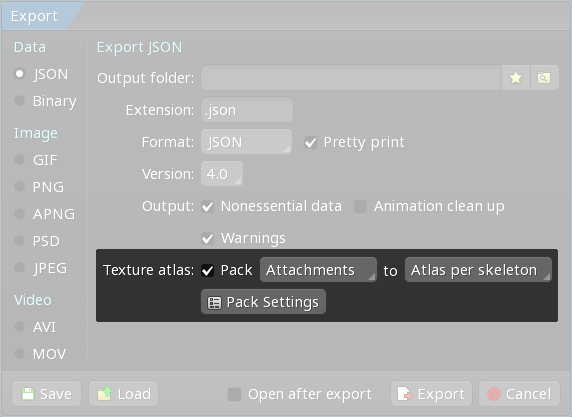

- #Libgdx does texturepacker compress for mac os#
- #Libgdx does texturepacker compress code#
- #Libgdx does texturepacker compress download#
When you change screens try to load/dispose only dynamic textures (for example if every your level has different background, you can load/dispose this backgrounds).Don't dispose this textures until game closing.If your game is small you can load all game textures here. On the game start show loading screen and load all often usable textures (like buttons, main menu graphic, main character, dialogs etc) with AssetManager.You can find lots of useful information about AssetManager and resources management here Managing your assetsĪbout your second question: I don't recommend you to dispose/load all textures when you change screens. I recommend you to use AssetManager for loading and disposing your resources. It is very hard to manage memory and control which texture will be removed by GC when you minimize your game or in other similar cases. I, Tommy Ettinger, am very grateful to the large and friendly LibGDX community as well.It is a bad idea to hold all your texture is static array in static class.
#Libgdx does texturepacker compress code#
CreditsĪlmost all the work that went into this was done already by LibGDX developers, particularly who wrote much of the TexturePacker code this uses. Save config.json and run again to see if the failure message goes away. jar is whatever the default is for Java on your computer, which is usually 256 megabytes, and config.json can reduce the maximum memory it uses as well ( "-Xmx512M" for 512 megabytes, "-Xmx256M" for 256 megabytes, "-Xmx128M" for 128 megabytes, and I wouldn't recommend going lower than that). You can also reduce the limit if memory is at a premium on the computer running the packer the default on the. The line that determines this in config.json looks like "-Xmx1G", all you need to do to increase the limit is change it to "-Xmx2G" for 2 gigabytes, "-Xmx3G" for 3 gigabytes, and if you somehow need more, remember that you can have multiple atlases if you have truly massive quantities of images (or very large images).

#Libgdx does texturepacker compress for mac os#
app version for Mac OS X, you need to open it as a folder and find it at GDXTexturePacker.app\Contents\MacOS\config.json) to change the default memory maximum if you need more. You can edit the config.json file included with the platform-specific binaries (it's inside the.

jar) on the Releases tab default to 1 gigabyte of RAM used for this program, which should be enough for at least 50 1024x1024 pages of textures. Exceptionally large amounts of images may use all the memory the JVM has available to it, which has a default that is rather tiny. If you are packing a large number of images, you may want to include a pack.json file with at least the option fast: true set and possibly the stripWhitespaceX and stripWhitespaceY options set to true as well, though the last two require additional code to work properly. Check the output directory you specified and see how well your images compressed! Troubleshooting It could also crash if there are far too many images for your computer to handle, which also can occur with libGDX's command-line TexturePacker. The blue "Processing." message to the right should change to a green "SUCCESS!" once things are done, or possibly a red "PROCESSING FAILURE." if something went wrong. Once you've entered at least the top two fields, click the bottom "Pack Textures!" button and wait for it to complete, which may take a while on larger sets of images. The format for pack.json files is a simplified version of JSON (so it can be edited with any text editor), and is described here. You can optionally include a file with the name "pack.json" in each folder with additional configuration. Running the jar or other executable presents you with a simple GUI: select the input folder that contains the images to pack, select the output folder (preferably an empty one, to avoid potentially overwriting something), and prefix for the atlas and texture pages (the default, "pack", will result in "pack.atlas" and "pack.png" as the first files it generates entering "monsters" will make "monsters.atlas" and "monsters.png").
#Libgdx does texturepacker compress download#
jar download unless you don't have Java installed. There are several downloads on the Releases tab of this project you probably want the. This is an attempt to change that, using libGDX's code as a base. There's a commercial packer with a GUI and an older wrapper around libGDX's TexturePacker, but nothing recent that packs textures for libGDX has had both a GUI and a $0 price tag. Unfortunately for some developers, it isn't the easiest tool to use. LibGDX provides a very full-featured way to pack many images into one texture with its TexturePacker tool. A standalone version of libGDX's TexturePacker with a GUI


 0 kommentar(er)
0 kommentar(er)
